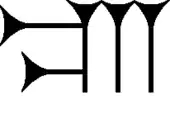MÁ
The cuneiform sign MÁ denotes a ship or boat. It is used in Sumerian and as a Sumerogram for the Akkadian word eleppu (also 'ship'/'boat').[1] MÁ is usually preceded by the determinative for items made of wood, namely ![]() GIŠ: GIŠ.MÁ, or GIŠ.MÁ,
GIŠ: GIŠ.MÁ, or GIŠ.MÁ, ![]()
![]() .
.

Digital rendering of the sign MÁ. In the variant found in the Amarna letters, the lower horizontal crosses all three verticals.
Examples
The Epic of Gilgamesh lists sixteen wood-related words written with the GIŠ determinative, among them GIŠ.MÁ/eleppu.[2] The epic also uses the 'ship'/'boat' Sumerogram in Tablet XI (the Gilgamesh flood myth), and elsewhere when Gilgamesh is taken by boat.
Some of the Amarna letters using the Sumerogram are EA 86, EA 153,[3] EA 149, EA 245,[4] and EA 364.[5]
References
- Parpola, 1971. The Standard Babylonian Epic of Gilgamesh, Glossary, pp. 119-145, eleppu, p. 124.
- Parpola, 1971. The Standard Babylonian Epic of Gilgamesh, Glossary and Indices, Logograms and Their Readings, pp. 117-18, p. 117.
- Image. GIŠ.MÁ, found in line 10.
- Image. GIŠ.MÁ found in line 4 of the reverse.
- Image. From Ayyab, it is one of the shorter Amarna letters.
Bibliography
- Simo Parpola; Kalle Fabritius (1997). Simo Parpola; Mikko Luukko; Kalle Fabritius (eds.). The standard Babylonian Epic of Gilgamesh : cuneiform text, transliteration, glossary, indices and sign list. Translated by Simo Parpola. Neo-Assyrian Text Corpus Project (Contributor). Helsinki: Neo-Assyrian Text Corpus Project. ISBN 951-45-7760-4. OCLC 38502035. (Volume 1) in the original Akkadian cuneiform and transliteration; commentary and glossary are in English
External links
- Amarna letter EA 153-(Obverse), line 10 (7th line from bottom)
- Amarna letter EA 245-(Reverse), line 4(=line 28) (4th line from top-of-reverse)
This article is issued from Wikipedia. The text is licensed under Creative Commons - Attribution - Sharealike. Additional terms may apply for the media files.